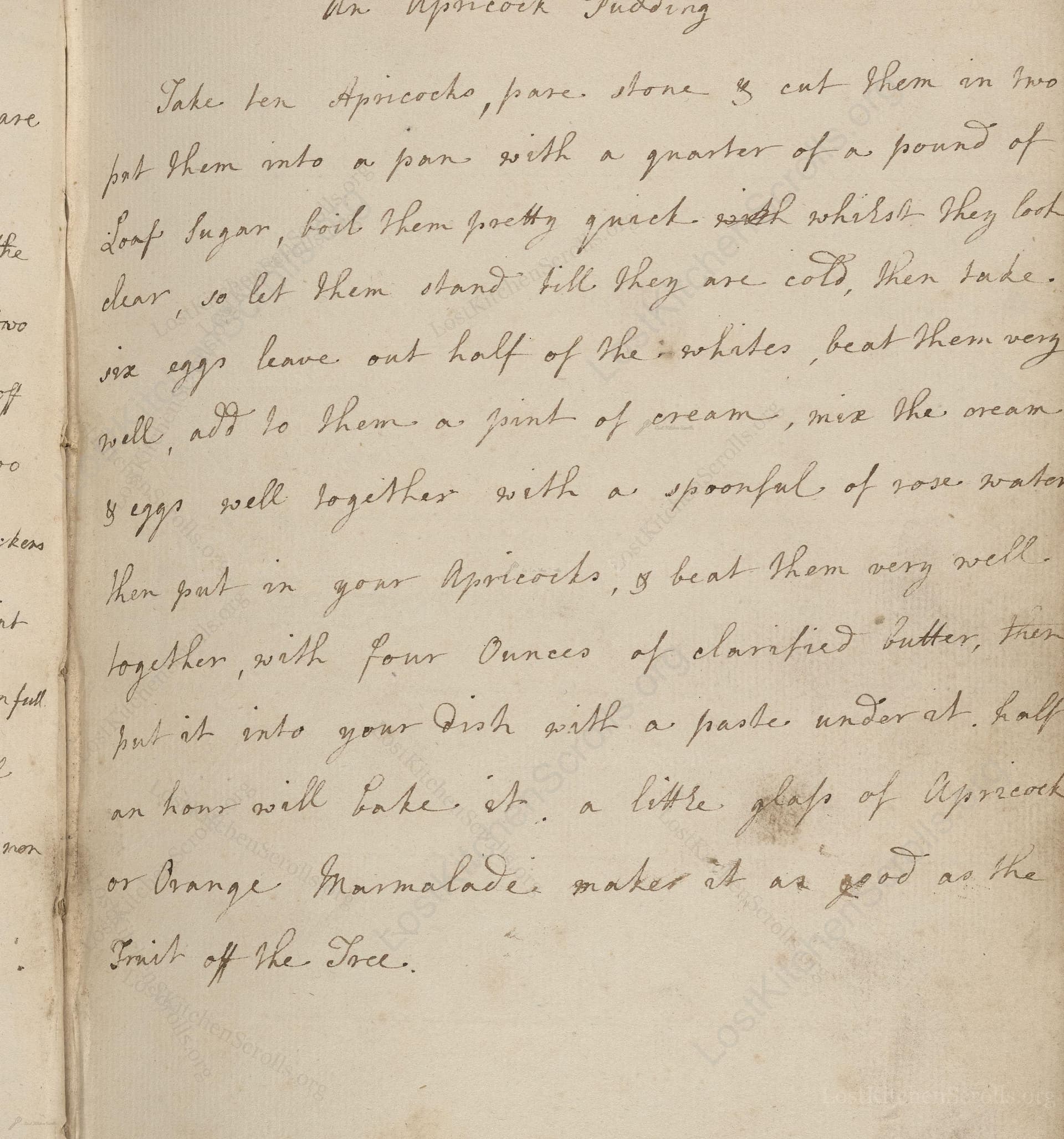An Apricock Pudding
From the treasured pages of Cookbook of Elizabeth Langley
Written by Elizabeth Langley

An Apricock Pudding
"Take ten Apricocks, pare. stone & cut Them in two put Them into a pan, with a quarter of a pound of Loaf Sugar, boil Them pretty quick, with whilst They look clear, so let them stand till They are cold, Then take. six eggs leave out half of the whites, beat them very well, add to Them a pint of cream, mix the cream & eggs well together with a spoonfull of rose water Then put in your Apricocks, & beat Them very well. together, with four Ounces of clarifid Butter, then put it into your Dish with a paste under it. half an hour will bake it. a little glass of Apricock or Orange Marmalade makes it as good as the Fruit of the Tree."
Note on the Original Text
Langley's recipe uses period spellings like "Apricock" (apricot), "pare" (peel), and "clarifid Butter" (clarified butter). Instructions are written as a continuous narrative rather than as separate steps, requiring the cook to have a certain familiarity with the processes involved. The precise temperatures and timings were largely absent—'half an hour will bake it'—so experience and intuition played a large role. Quantities such as 'a quarter of a pound' are given in imperial weights, which have been carefully converted here.

Title
Cookbook of Elizabeth Langley (1757)
You can also click the book image above to peruse the original tome
Writer
Elizabeth Langley
Era
1757
Publisher
Unknown
Background
Step into the Georgian kitchen with Elizabeth Langley's 1757 culinary collection, where refined techniques and delightful recipes await those with a taste for historic gastronomy.
Kindly made available by
Folger Shakespeare Library
This recipe was written by Elizabeth Langley in 1757, during the Georgian era in England—a time when sugar had become more accessible to the upper classes and exotic ingredients like rose water and apricots were prized luxuries. Recipes like this apricot pudding reflect both the opulence and whimsy of 18th-century dessert tables, as well as the emerging French-inspired fashion for delicate, custard-based sweets baked in pastry. The manuscript would have likely been used in a well-to-do household, carefully documented by a knowledgeable cook or homemaker for use during lavish gatherings or for family meals.

In the 18th century, the preparation would have relied on a heavy copper or tin saucepan for boiling the fruit, a wooden spoon for stirring, and a large earthenware or pewter bowl for beating the eggs and mixing the custard. Eggs might be beaten with simple bundles of twigs (the forerunner of the modern whisk). Baking would be done in a brick oven, and the pastry case placed in a ceramic or metal dish. Measuring was done by weight (using balance scales) and approximations, rather than by volume.
Prep Time
30 mins
Cook Time
30 mins
Servings
8
We've done our best to adapt this historical recipe for modern kitchens, but some details may still need refinement. We warmly welcome feedback from fellow cooks and culinary historians — your insights support the entire community!
Ingredients
- 10 ripe apricots (or 10 canned apricot halves, well drained, if fresh unavailable)
- 4 oz white sugar (loaf sugar)
- 6 eggs (using 3 whites and all 6 yolks)
- 1 cup double cream
- 1 tbsp rose water
- 4 oz unsalted butter, clarified/melted
- 1 pre-made or homemade shortcrust pastry for lining the dish
- 1-2 tbsp apricot or orange marmalade (optional)
Instructions
- Begin by preparing 10 ripe apricots: peel, remove the stones, and slice them in half.
- Place the apricots in a saucepan with 4 oz of white sugar.
- Cook over medium-high heat, stirring, until the fruit softens and becomes translucent, then allow the mixture to cool.
- In a separate bowl, beat 6 eggs, discarding the whites from 3 of them (so use 6 yolks and 3 whites), until well combined.
- Stir in 1 cup of double cream and 1 tablespoon of rose water.
- Mix this custard base thoroughly with the cooled apricots.
- Add 4 oz of melted unsalted butter.
- Pour the mixture into a pie dish lined with shortcrust pastry.
- Bake at 350°F for about 30 minutes, until the custard is set and the pastry golden.
- Optionally, for a deeper apricot flavor, add 1 to 2 tablespoons of apricot or orange marmalade to the filling before baking.
Estimated Calories
370 per serving
Cooking Estimates
Preparing the apricots, mixing the custard, and assembling the tart takes about 30 minutes. Baking takes another 30 minutes. Each slice has about 370 calories, and the tart serves 8 people.
As noted above, we have made our best effort to translate and adapt this historical recipe for modern kitchens, taking into account ingredients nowadays, cooking techniques, measurements, and so on. However, historical recipes often contain assumptions that require interpretation.
We'd love for anyone to help improve these adaptations. Community contributions are highly welcome. If you have suggestions, corrections, or cooking tips based on your experience with this recipe, please share them below.
Join the Discussion
Rate This Recipe

Den Bockfisch In Einer Fleisch Suppen Zu Kochen
This recipe hails from a German manuscript cookbook compiled in 1696, a time whe...

Die Grieß Nudlen Zumachen
This recipe comes from a rather mysterious manuscript cookbook, penned anonymous...

Ein Boudain
This recipe comes from an anonymous German-language manuscript cookbook from 169...

Ein Gesaltzen Citroni
This recipe, dating from 1696, comes from an extensive anonymous German cookbook...
Browse our complete collection of time-honored recipes



